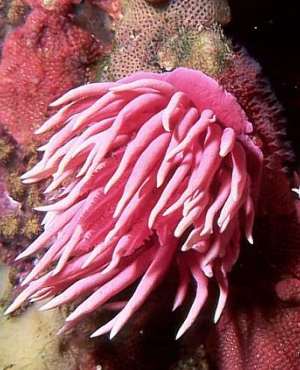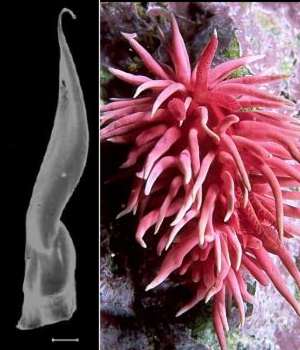

Okenia rosacea
(Macfarland, 1905)
Order: NUDIBRANCHIA
Suborder: DORIDINA
Superfamily: ANADORIDOIDEA
Family: Goniodorididae
DISTRIBUTION
West Coast of Nth America from Oregon south to Baja California.
PHOTO
Upper:off Laguna Beach, California. Animal, approximately one inch long [2.4mm], feeding on the pink bryozoan, Integripelta bilabiata. Photo: Bruce Wight. Lower Right: Shaw's Cove, Laguna Beach, California, January, 2002. Photo: Bruce Wight. Lower Left: SEM of single inner lateral radular tooth. Scale bar = 400 µm. Photo: T.M.Gosliner.
NOTE: This species was previously known on the Forum as Hopkinsia rosacea.
The animal has a low flattened profile and from above, the mantle, foot and head are merged into one, although ventrally a V-shaped groove indicates the junction of the head and the foot. There are no oral tentacles. The dorsal surface is covered with long soft papillae, which taper to a rounded tip. They are numerous near the edge of the dorsum and less so in the central region between between the gills and the rhinophores. The gills and rhinophores are about two-thirds the length of the papillae and similar in shape, tapering to a blunt tip. There are up to 20 simple gills, pointing posteriorly, and arranged in an circle, open posteriorly, around the anal papilla.
The whole of the animal is pink. Often the tips of the dorsal papillae, rhinophores and gills are paler whitish pink. There is some variation in the intensity of the pink, and in some animals there is a considerable amount of white on the papillae. It grows to approximately 30 mm in length.
Although the radula has the typical goniodorid pattern of one large inner and one small outer lateral teeth on each side of a row, the shape of the teeth in O. rosacea is quite unique. The inner lateral teeth are elongate, tapering to a recurved hook-like tip. The outer lateral teeth are reduced to a small vestigial plate. The peculiarities of the anatomy caused MacFarland (1905) to erect a new genus, Hopkinsia, for this species. Gosliner (2004) recently proposed synonymising the genera Hopkinsia and Hopkinsiella with Okenia. Like many of the 'Hopkinsia-group' of species, O. rosacea has a relatively broad flattened body in which the head and foot are fused, the lateral papillae are relatively large and crowded, and the body, like its food, is reddish pink. In external shape, it has many similarities to Okenia hiroi which lives on the western side of the northern Pacific, and they both feed on eurystomellid bryozoans of the genus Integripelta (see Rudman, 2004). The elongate hook-shaped inner lateral tooth of O. rosacea also link it to the recently described central Pacific species, O. nakamotoensis.
Okenia rosacea is usually found associated with a similarly coloured cheilostomatous bryozoan. The colour match is not a coincidence as they both share the same pigment, hopkinsiaxanthin, presumably obtained by the nudibranch from its food (McBeth, 1971). The food bryozoan of O. rosacea is a cheilostomatous bryozoan [Fam: Eurystomellidae] normally named Eurystomella bilabiata. A recent revision of the bryozoans has moved its generic placement so its name is now Integripelta bilabiata (see Gordon, Mawatari & Kajihara, 2002).
- Bertsch, H. (1989) Life history of the intertidal Californian nudibranch Hopkinsia rosacea MacFarland, 1905. Western Society of Malacologists, Annual Report, 21:19-20.
- Gordon, D.P., Mawatari, S. F., & Kajihara, H, 2002. New taxa of Japanese and New Zealand Eurystomellidae (Phylum Bryozoa) and their phylogenetic relationships. Zoological Journal of the Linnean Society, 136: 199-216.
-
Gosliner, T. M. (2004) Phylogenetic Systematics of Okenia, Sakishimaia, Hopkinsiella and Hopkinsia (Nudibranchia: Goniodorididae) with descriptions of new species from the tropical Indo-Pacific. Proceedings of the California Academy of Sciences, 55: 125-161.
-
McBeth, J.W. (1971) Studies on the food of nudibranchs. The Veliger, 14, 158-161.
-
Rudman, W.B. (2004) Further species of the opisthobranch genus Okenia (Nudibranchia: Goniodorididae) from the Indo-West Pacific. Zootaxa, 695: 1-70.
-
Strain, H. H. (1949) Hopkinsiaxanthin, a xanthophyll of the sea slug Hopkinsia rosacea. Biological Bulletin, 97(1):206-209.
ARCHIVE NOTE: An earlier edition of this Fact Sheet [1 May 2000] as Hopkinsia rosacea is available on request.
Authorship detailsRudman, W.B., 2004 (December 21) Okenia rosacea (Macfarland, 1905). [In] Sea Slug Forum. Australian Museum, Sydney. Available from http://www.seaslugforum.net/factsheet/hopkrosa
Related messages
-
Photos of Okenia rosacea - Hopkins' Rose
From: Kevin Lee, February 5, 2007 -
Re: Okenia rosacea - feeding & breeding
From: Phil Garner, September 5, 2006 -
Re: Okenia rosacea - feeding & breeding
From: Kevin Lee, December 15, 2005 -
Re: Okenia rosacea - feeding & breeding
From: Jeff Goddard, December 14, 2005 -
Okenia rosacea - feeding & breeding
From: Kevin Lee, December 13, 2005 -
Okenia rosacea or Hopkins Rose
From: Michael Jimenez, December 6, 2005 -
Many new species of Okenia
From: Bill Rudman, December 21, 2004 -
Hopkinsinia rosacea from Catalina Island, CA
From: James Lyle, February 27, 2004 -
Hopkinsia rosacea - food
From: Alan Grant, February 19, 2002 -
Information on Hopkinsia rosacea
From: Sarah Heinemann, January 30, 2002 -
Hopkinsia rosacea from Shaw's Cove
From: Bruce Wight, January 30, 2002 -
Photos of Hopkinsia rosacea
From: Bruce Wight, June 28, 2000 -
A photo of Hopkinsia rosacea
From: Dave Behrens, May 4, 2000 -
Hopkinsia rosacea
From: Juniscilla, May 3, 2000
